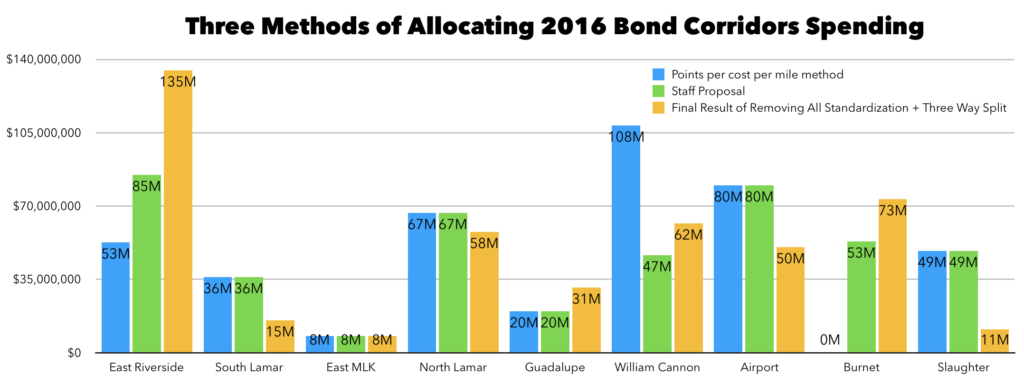In 2016, Austin voters approved a $720 million transportation bond. The city branded it as a Mobility Bond and authorized a Contract with Voters to facilitate accountability of such a large-scale set of expenditures.
The contract lays out how the bond money should be split among three categories. $137m for local mobility projects, $101m for regional projects, and $482m is specifically allocated to Corridor Improvement Projects.
These 9 corridors were the location of 13% of transportation deaths and serious injuries in Austin over the last five years. The projects that are ultimately selected and the design choices for each one can make significant progress towards Austin’s Vision Zero goal of ending transportation deaths by 2025.
The contract promises completion of bond expenditures by 2024. With that aggressive timeline, City Council is set to allocate the funding for the final set of 2016 Bond corridor projects at the April 26 council meeting (Item 28).
City staff identified $1.4 billion in need to completely fulfill the planned improvements to these nine Corridor Improvement Projects. To choose between these projects, the city hired a consultant to develop a prioritization matrix based on the Contract with the Voters.
The Double Normalization Problem
Nic Moe, former volunteer Chair of Vision Zero ATX and graduate student in Public Health, noticed some issues with the prioritization process as a member of the stakeholder group late in 2017 and discussed them with us. He worried that a logical error had occurred in the development of the basic equations that underlie the matrix, specifically the idea of standardizing many variables by project length, and then performing a second standardization by length at the end of the process. He sent these concerns to the Corridor Mobility Program Office in December, and had the opportunity to meet with and discuss these issues with staff, but they were apparently not convinced of the problem.
Once the staff recommendation was made public, we eagerly dug in, but the data and the matrix were not public – even as late as the initial city council meeting where they were originally scheduled to allocate half a billion dollars based upon this work. A Public Information Request was filed, resulting in the release of the data a couple weeks later. Staff released a memo explaining the approach to the matrix and trying to argue against the critique. We do not believe that the explanation in this memo is satisfactory.
Simply standardizing every single benefits per mile and then standardizing the final score by cost per mile would not introduce a mistake in the matrix, but also would be pointless.
However, standardizing some community and mobility benefits per mile, but not standardizing others, adding all of those up, then dividing by cost per mile, caused the matrix to be dominated simply by the total mileage of the proposed project.
The average length of the projects selected by the staff proposal is 4.57 miles, while the average length of the projects rejected by the staff proposal is 1.61 miles. Yet the average total benefit of the projects that were rejected is higher both for community and mobility benefits.
We will be publishing in depth explanations from Nic Moe showing his analysis of the impact of project length on selection as well as analysis comparing the benefits of the original staff set of projects and the alternative set of proposed projects produced when you remove the standardization error.
The Corrected List of Projects
We removed the initial standardization by mile from the mobility metrics and the standardization by mile in the final step of the prioritization matrix to produce a new ranking of all projects. We believe this method simply allocates money based upon the highest bang for the buck – the most possible total community benefits per dollar spent.
The list linked below is presented with the projects in order of final score with the first project – East Riverside Drive corridor wide improvements – being the highest scoring project. This final score is the combined community and mobility benefits – using the same 60% / 40% split proposed by staff – divided by cost. As was done with the staff proposal, we have split this list between Full Design & Construction, Initiate Design & Construction, Seek Additional Funding Opportunities.
Corrected Corridors Prioritized List (pdf)
Using this list, there are 15 high scoring projects that add up to $410 million. Adding the next project – Airport from Manor to 183 – would cause the total to be greater than the original staff proposal. We are proposing that City Council to fund additional study on Initiate Design and Possible Construction for nine other projects, and to prioritize partial funding of several of these projects with the remaining funds.
Using the fixed prioritization model shows that both Slaughter Lane projects score fairly low in terms of the community and mobility benefits. However, there has been a stated goal of geographic spread, which staff seems to have interpreted as having some funds for each of these nine corridors.
Enhanced treatments for The Drag section of Guadalupe has been in various community planning processes for almost 15 years, with an initial plan completed in 2003. This section has been the most discussed element of the Corridors plan in the last several years, and is home by far to the highest density of residents, jobs, and students, meaning that targeting investments here will improve more people’s lives. This corridor today sees almost twice as much transit use as the second highest corridor – North Lamar.
Thus we propose a starting point for council deliberation of prioritizing the use of these remaining funds would be to split them up equally between the enhanced Guadalupe project, the systemwide improvements Slaughter Lane project, and the Enhanced Airport project from Manor to 183 – at $11.26 million each.
April 17 Mobility Committee Discussion
The Data
The staff response to a PIR request (pdf)
Corridor Scores With Double Normalization Removed (xlsx)
[Featured Image: Earl McGehee, CCL, Some Rights Reserved]
Clarification
At the April 28th Mobility Committee meeting, I incorrectly stated that Nic brought this to the corridors office attention and that he didn’t hear back. I talked to Nic this morning to clarify everything and learned that this was incorrect. Nic was able to meet with staff and discuss his concerns through one phone call. He said that staff were excellent and responsive throughout the process. We simply still have a disagreement about the methodology. However I am personally very sorry for my mistake in implying that staff were not responsive.
Signed Jay Blazek Crossley


